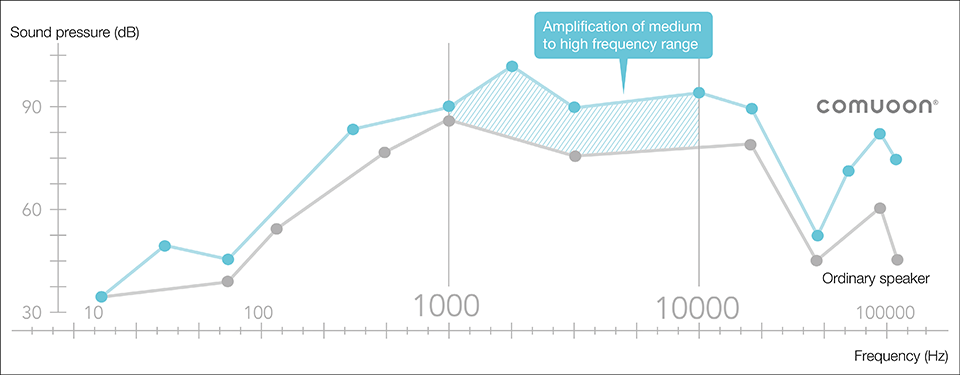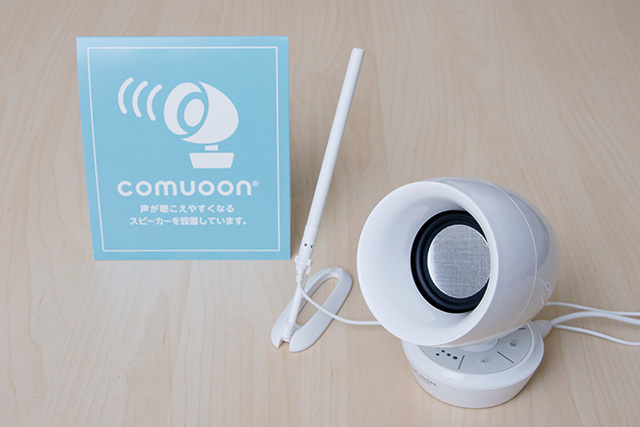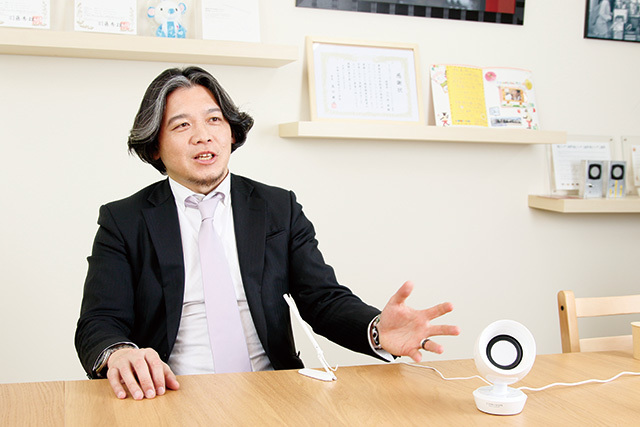Japan, due to its aging population, has a growing number of senior citizens with age- related hearing loss. It also has increasing numbers of non-seniors with hearing issues due to causes including noise-induced hearing loss and stress. Universal Sound Design, a Tokyo- based start-up, has developed a unique communication support system called “comuoon®” to provide communication support for the hard of hearing.
The comuoon system consists of a slim microphone and a specially designed speaker. When a person talks into the microphone, his or her voice can be heard from the speaker unit with the sound enhanced to be more audible to a hearing-impaired listener. It can serve in place of a hearing aid for those with moderate hearing impairments who can hear loud sounds but have a hard time understanding normal speech. This system allows those who are speaking to proactively help the listener, instead of placing the burden on the listener to take actions to boost his or her hearing. This is the concept behind the development of comuoon.
Sound pressure: comuoon vs. ordinary speaker
By raising the sound pressure in medium and high frequency ranges, comuoon enhances the clarity of sounds in the ranges around the consonants, which hearing- impaired people commonly have difficulty understanding.
Hearing aids have improved considerably, but many people living with hearing loss do not use them because they amplify all sounds, including unneeded ones. Universal Sound Design CEO Shinichiro Nakaishi, who developed comuoon, says that his father had a hearing problem that interfered with everyday conversation. This was what motivated him to create something that would allow hearing-impaired people to converse without the need for a hearing aid. The specifics of hearing impairments differ from person to person, but such impairments tend interfere with the hearing of consonants. This tendency is particularly strong in the case of the high-frequency sounds of k, s, and t, making it difficult for people with hearing problems to catch words containing these sounds. Simply increasing the volume does not help. As Nakaishi explains, what is important is the clarity of the sound, not the volume.
The comuoon system consists of a slim microphone and a speaker.
Systems with wireless microphones are also available, allowing students with hearing problems to sit at a distance from the teacher.
The comuoon system, which was completed at the end of 2013, resolves sounds into their component parts, reduces noise, and amplifies volume in the frequency ranges around consonants, thereby making sounds clearer. Speaker diaphragms are normally made of paper, but the comuoon speaker uses a newly developed aluminum component with a honeycomb structure that enhances resonance. The speaker’s ovoid shape keeps the sound from scattering, providing high directionality that delivers sound straight to the listener’s ears. University experiments have verified the globally unmatched efficacy of this device.
Comuoon systems are far from cheap, but about 3,000 of them have already been sold in a little over two years. They have been installed in hospitals, at bank counters, and elsewhere, facilitating communication with the hard of hearing. They are also being used in schools and classes for the hearing impaired, and thanks to them, students happily report that they can hear better.
Universal Sound Design aims to promote comuoon globally and is currently testing the system in countries including the United States, which, like Japan, has a growing population of seniors. Nakaishi is eager to spread this system in the lead-up to the 2020 Tokyo Olympics and Paralympics, saying that his ultimate goal is to accomplish “barrier-free listening.”
Shinichiro Nakaishi, CEO of Universal Sound Design, formerly worked for a major record company. Assigned to new business development, he did research on speakers for concert use. It was during this time that he discovered sounds that are easier to perceive for those with hearing loss. This led to development of the comuoon system.



































































































































